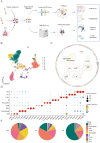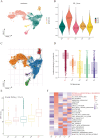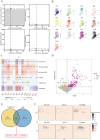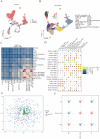Single-Cell RNA Sequencing Reveals the Critical Role of SEC16B in Lung Metastasis of Osteosarcoma
- PMID: 40735296
- PMCID: PMC12301935
- DOI: 10.1096/fba.2024-00161
Single-Cell RNA Sequencing Reveals the Critical Role of SEC16B in Lung Metastasis of Osteosarcoma
Abstract
Osteosarcoma (OS) is highly malignant and easily prone to lung metastasis. The mechanisms of lung metastasis in OS remain unclear. The single-cell RNA sequencing (scRNA-seq) samples in this study included six primary osteosarcoma samples (published in-house data), two lung metastasis samples (GSE152048), and four normal bone tissue samples (GSE169396). To identify potential targets for metastasis, bulk RNA sequencing data from four primary tumors and four lung metastases (in-house data) were also analyzed. scRNA-seq identified five tumor cell subpopulations. CytoTRACE and lung metastasis scores indicated that the C1 subpopulation was most closely associated with lung metastasis. By intersecting lung metastasis-related genes identified via hdWGCNA analysis with differentially expressed genes from bulk RNA sequencing, SEC16B was identified as the key gene influencing lung metastasis. qRT-PCR results revealed that SEC16B expression was significantly downregulated in OS cell lines. Transwell assay demonstrated that overexpression of SEC16B significantly inhibited the invasion and migration capabilities of OS cells. Additionally, analyses using Scissor, CellphoneDB, and CSOmap suggested that fibroblasts, endothelial cells, and OS cells in the tumor microenvironment formed a pre-metastatic niche through mechanisms involving angiogenesis and extracellular matrix remodeling. Overall, this study identifies a new population that may promote lung metastasis by downregulating SEC16B in OS. Moreover, fibroblasts and endothelial cells in the tumor microenvironment play a critical role in OS lung metastasis.
Keywords: lung metastasis; osteosarcoma; single‐cell transcriptomics; tumor microenvironment.
© 2025 The Author(s). FASEB BioAdvances published by Wiley Periodicals LLC on behalf of The Federation of American Societies for Experimental Biology.
Conflict of interest statement
The authors declare no conflicts of interest.
Figures






Similar articles
-
Aberrant Activation of Wound-Healing Programs within the Metastatic Niche Facilitates Lung Colonization by Osteosarcoma Cells.Clin Cancer Res. 2025 Jan 17;31(2):414-429. doi: 10.1158/1078-0432.CCR-24-0049. Clin Cancer Res. 2025. PMID: 39540841 Free PMC article.
-
Identification of biomarkers for Laryngeal squamous cell carcinoma through Mendelian randomization and integrated bioinformatics analysis.Discov Oncol. 2025 Jul 18;16(1):1364. doi: 10.1007/s12672-025-03114-w. Discov Oncol. 2025. PMID: 40679719 Free PMC article.
-
Integrating single-cell and spatial transcriptomics reveals endoplasmic reticulum stress-related CAF subpopulations associated with chordoma progression.Neuro Oncol. 2024 Feb 2;26(2):295-308. doi: 10.1093/neuonc/noad173. Neuro Oncol. 2024. PMID: 37772937 Free PMC article.
-
Systemic treatments for metastatic cutaneous melanoma.Cochrane Database Syst Rev. 2018 Feb 6;2(2):CD011123. doi: 10.1002/14651858.CD011123.pub2. Cochrane Database Syst Rev. 2018. PMID: 29405038 Free PMC article.
-
Pathobiology and Molecular Pathways Implicated in Osteosarcoma Lung Metastasis: A Scoping Review.Technol Cancer Res Treat. 2025 Jan-Dec;24:15330338251359716. doi: 10.1177/15330338251359716. Epub 2025 Jul 17. Technol Cancer Res Treat. 2025. PMID: 40676851 Free PMC article.
References
LinkOut - more resources
Full Text Sources
